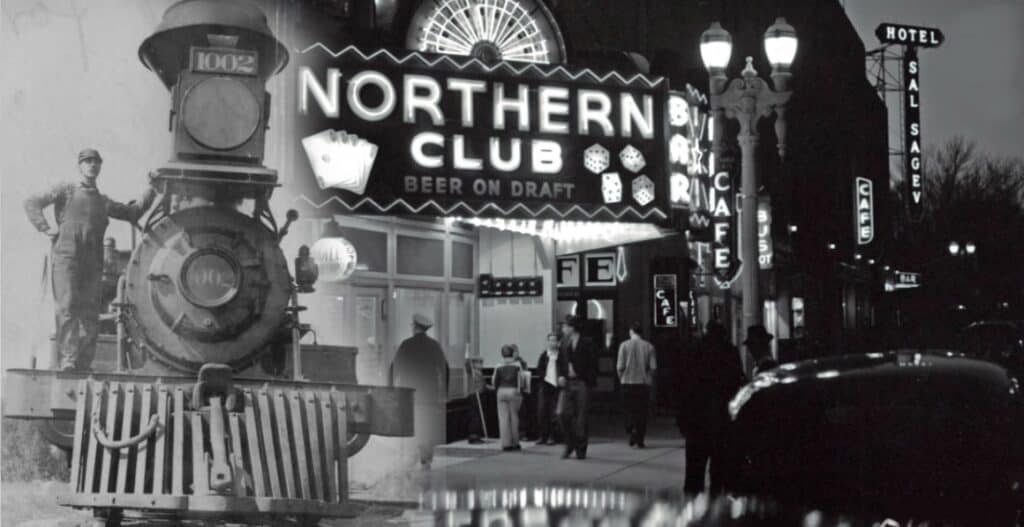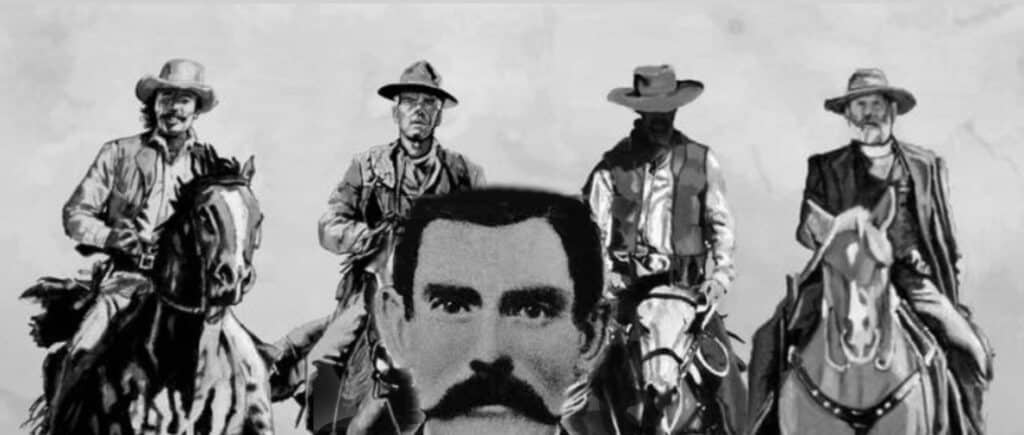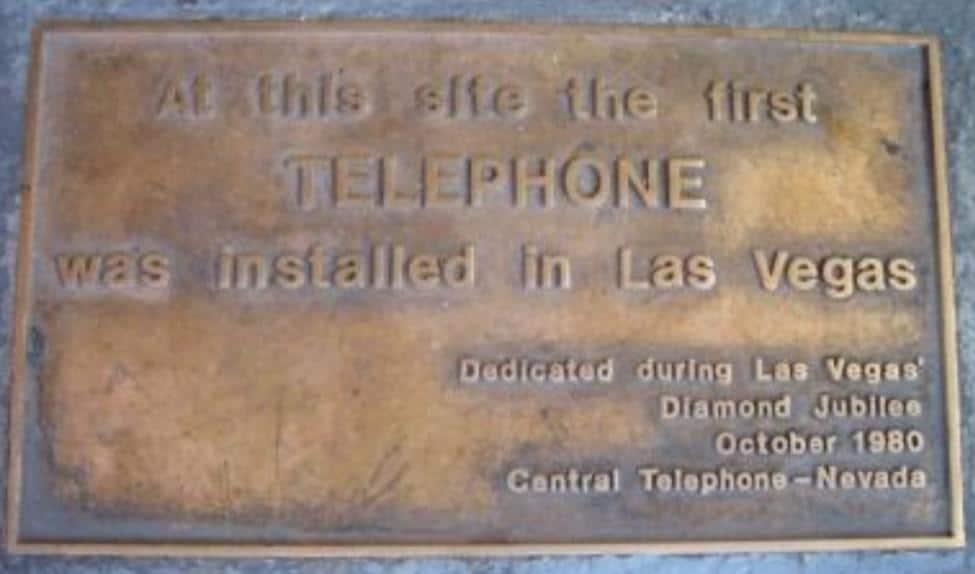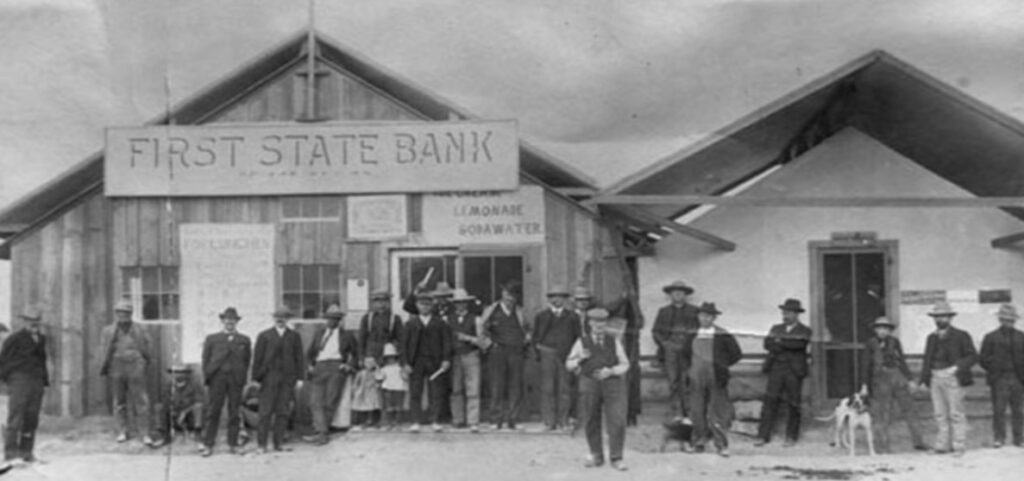
Las Vegas History: The Railroad’s Strategic Land Acquisitions and the Impact of The Railroad on Las Vegas
Helen J. Stewart played a significant role in the history of Las Vegas through her ownership and sale of land to the San Pedro ranch, which eventually led to the establishment of the townsite. Here is the full history of her involvement and the land transactions that took place:
Helen J. Stewart acquired land in the area around Las Vegas in 1882. Over the years, she expanded her ranch, eventually amassing 1,800 acres of property. Her ranch became a central hub for local ranching activities, and she actively participated in the development and growth of the region.
In the early 1900s, the Los Angeles & Salt Lake Railroad (also known as the San Pedro, Los Angeles & Salt Lake Railroad) sought to extend its railway line into the Las Vegas area as part of its expansion plans. Recognizing the strategic location of Helen J. Stewart’s ranch, the railroad company approached her with an offer to purchase her land.
After negotiations, Helen J. Stewart agreed to sell her 1,800-acre ranch to the San Pedro ranch. The sale took place, and the railroad company acquired the land, intending to utilize it for the development of a townsite in Las Vegas.
With the acquisition of the land, the San Pedro ranch proceeded to auction off the property on May 15, 1905. This auction marked the beginning of the process of building the Las Vegas townsite. Interested parties, including individuals, businesses, and investors, had the opportunity to bid on the land parcels.
The auction of the land was a pivotal moment in the history of Las Vegas. It attracted settlers, entrepreneurs, and developers who recognized the potential of the area. The sale of the land parcels during the auction laid the foundation for the establishment of the town, as individuals acquired plots of land to begin their ventures and build the infrastructure needed for a growing community.
Over time, the townsite of Las Vegas expanded and developed into the vibrant city it is today. The acquisition of Helen J. Stewart’s ranch by the San Pedro ranch, followed by the auction of the land, provided the initial impetus for growth and development in the Las Vegas area.
Helen J. Stewart’s decision to sell her land played a role in shaping the early history of Las Vegas and its transformation into a bustling town. Her contribution to the development of the region is recognized as a significant milestone in the city’s history.
The sale of Helen J. Stewart’s ranch to the San Pedro ranch marked a turning point in the development of Las Vegas. With the land now in the hands of the railroad company, the stage was set for the growth and expansion of the town. Here is a continuation of the history:
Following the land auction, the new landowners, the San Pedro ranch, began laying the groundwork for the development of the Las Vegas townsite. Streets were surveyed, lots were plotted, and infrastructure plans were put in motion. The initial focus was on creating a functional and organized layout for the growing community.
With the availability of land parcels, individuals, families, and businesses seized the opportunity to acquire property and establish their presence in Las Vegas. The influx of settlers and entrepreneurs brought diverse backgrounds, skills, and ambitions, contributing to the dynamic and eclectic character of the developing town.
The construction of essential infrastructure quickly followed. Roads were built, water supply systems were established, and basic amenities were put in place to support the growing population. Businesses began to emerge, offering goods and services to meet the needs of the community. The railroad played a vital role in connecting Las Vegas to regional and national markets, facilitating trade and commerce.
As the town continued to evolve, it attracted more settlers, investors, and entrepreneurs. The development of the railroad and the availability of land offered opportunities for various industries, such as mining, agriculture, and tourism, to flourish. Hotels, shops, and entertainment venues sprang up, catering to the needs and desires of residents and visitors alike.
Over time, Las Vegas became known as a destination for entertainment and leisure. The city’s reputation for casinos, resorts, and vibrant nightlife started to take shape, attracting visitors from near and far. The growth of the town created employment opportunities and a sense of community, further fueling its expansion.
The original 1,800-acre ranch owned by Helen J. Stewart became the foundation upon which the modern city of Las Vegas was built. The vision, determination, and decision to sell her land played a pivotal role in shaping the town’s destiny and cementing its status as a vibrant and prosperous urban center.
Today, Las Vegas stands as a symbol of transformation and possibility. The sale of Helen J. Stewart’s land to the San Pedro ranch and the subsequent auction of the lots marked the beginning of a remarkable journey that continues to shape the city’s identity and attract millions of visitors each year.
The history of Las Vegas is a testament to the resilience, innovation, and entrepreneurial spirit that transformed a desert landscape into a world-renowned destination.
The acquisition of land by the railroad extended beyond Helen J. Stewart’s ranch, as other individuals recognized the potential value of their properties and sold them to the railroad company. The process of land acquisition played a significant role in the expansion of the railroad’s reach and the subsequent growth of Las Vegas. Here is further information about other land sales to the railroad:
Expansion of Railroad Holdings: As the San Pedro ranch (Los Angeles & Salt Lake Railroad) aimed to extend its railway line and develop the Las Vegas townsite, it actively sought to acquire additional land. Various landowners in the vicinity of Las Vegas saw the opportunity to sell their properties and contribute to the growing town’s development.
Land Speculators and Investors: Alongside individual landowners, land speculators and investors recognized the potential for profit by selling their land to the railroad. These individuals acquired land with the intention of selling it later at a higher price. The arrival of the railroad and the resulting demand for land in the area presented a favorable opportunity for them to capitalize on their investments.
Infrastructure and Urban Development: Selling land to the railroad contributed to the overall infrastructure and urban development of Las Vegas. The availability of land enabled the railroad company to lay down tracks, construct stations, and establish necessary facilities. This facilitated the expansion of the town, attracting more settlers, businesses, and amenities to support the growing population.
Land Auctions and Sales: Similar to the auction of Helen J. Stewart’s ranch, the railroad company conducted land auctions and negotiated individual sales to acquire additional parcels. These auctions and sales processes allowed interested parties to purchase land directly from the railroad, stimulating further growth and development within the town.
Townsite Planning and Layout: The land sales to the railroad were instrumental in defining the townsite’s planning and layout. The acquired land formed the foundation for the establishment of streets, lots, and blocks, shaping the physical structure of the growing community. The arrangement of residential, commercial, and public spaces reflected the collective vision for the town’s growth.
Economic Impact: The land sales to the railroad had a substantial economic impact on both the sellers and the broader community. The landowners who sold their properties to the railroad often received significant financial compensation, enabling them to invest in other ventures or improve their livelihoods. The railroad’s presence and the resulting growth of Las Vegas created employment opportunities, boosted commerce, and stimulated economic prosperity.
Through a combination of negotiated sales, land auctions, and the actions of land speculators and investors, the San Pedro ranch (Los Angeles & Salt Lake Railroad) acquired additional parcels of land in and around Las Vegas. These transactions formed the basis for the town’s expansion and contributed to its transformation into a thriving urban center.
The collective efforts of individuals who saw the potential in selling their land to the railroad, combined with the vision and investments of the railroad company, propelled the growth and development of Las Vegas into the bustling city we know today.
In the 1800s, the land around Las Vegas was generally not considered to be expensive compared to other more developed areas. The region was still relatively remote and had not yet experienced significant growth or urbanization. Land values were influenced by factors such as proximity to water sources, accessibility, and economic prospects at the time. However, it is challenging to provide an exact percentage increase in land prices from the 1800s to 2023 due to various factors such as market fluctuations, economic conditions, and specific locations within the region.
Over the years, the growth and development of Las Vegas, particularly as a popular tourist destination and thriving metropolitan area, have significantly increased land values. The expansion of the city’s infrastructure, the establishment of world-renowned resorts and casinos, and the overall economic prosperity have contributed to the rise in land prices. However, the exact percentage increase in land values would vary depending on factors such as the specific location within the Las Vegas area, zoning regulations, and market demand.
It’s worth noting that while land values have generally increased over time, fluctuations in the real estate market can occur, influenced by factors such as economic conditions, supply and demand dynamics, and market trends. Therefore, providing an accurate and specific percentage increase in land prices from the 1800s to 2023 would require a detailed analysis of historical data and current market conditions.
Las Vegas and Gambling History

Las Vegas History: Railroad Development Paved the Way for Las Vegas to Become the Gambling Capital of the World

Las Vegas History: Doc Holliday Famous Gambler Gunslinger and Resident of Las Vegas

Las Vegas History: How Las Vegas’ First Telephone Exchange Made Bugsy Siegel’s Race Wire Possible

Las Vegas History: The Official Naming of Las Vegas 1905

Las Vegas History: 1864 Las Vegas The Impact of Nevada Statehood

Las Vegas History: Las Vegas and It’s Vices in the 1850s
Las Vegas Land Acquisition and Development FAQ: Shaping the City's Destiny
1. Who was Helen J. Stewart, and how did she contribute to Las Vegas history?
Helen J. Stewart played a crucial role in Las Vegas history through her ownership and sale of land to the San Pedro ranch (Los Angeles & Salt Lake Railroad). Her decision to sell her ranch laid the foundation for the establishment of the Las Vegas townsite.
2. What motivated Helen J. Stewart to sell her land to the San Pedro ranch?
Recognizing the strategic location of her ranch, Helen J. Stewart sold her 1,800-acre property to the San Pedro ranch, which sought to extend its railway line into Las Vegas. The sale paved the way for the development of the townsite.
3. How did the land auction on May 15, 1905, impact the development of Las Vegas?
The land auction, resulting from Helen J. Stewart’s sale to the San Pedro ranch, marked the beginning of the Las Vegas townsite. The auction attracted settlers, entrepreneurs, and developers, providing them with opportunities to acquire land and contribute to the town’s growth.
4. What was the role of the San Pedro ranch in developing the Las Vegas townsite?
The San Pedro ranch, having acquired land from Helen J. Stewart, initiated the development of the Las Vegas townsite. The railroad company surveyed streets, plotted lots, and auctioned off land parcels, setting the stage for the town’s expansion.
5. How did the availability of land contribute to the growth of Las Vegas?
The availability of land, acquired through transactions with the San Pedro ranch, attracted diverse settlers, businesses, and investors to Las Vegas. The land became the canvas on which the town’s infrastructure, residential areas, and commercial spaces were built.
6. What impact did the expansion of the railroad have on Las Vegas’ growth?
The expansion of the railroad facilitated by land acquisitions played a vital role in connecting Las Vegas to regional and national markets. This connection boosted trade, commerce, and economic development, laying the foundation for the city’s prosperity.
7. How did the development of the Las Vegas townsite unfold after the land auction?
Following the land auction, the San Pedro ranch initiated town planning, surveyed streets, and provided opportunities for individuals and businesses to acquire land. This led to the construction of essential infrastructure and the establishment of a growing, organized community.
8. What industries thrived in Las Vegas due to the land acquisitions and railroad expansion?
The availability of land and the railroad’s impact facilitated the growth of various industries in Las Vegas, including mining, agriculture, and tourism. The city’s economic diversity contributed to its resilience and prosperity.
9. How did the increase in land values over the years shape the modern-day Las Vegas?
While land values in Las Vegas were relatively modest in the 1800s, subsequent urbanization, economic prosperity, and the city’s transformation into a tourist destination have significantly increased land values. This rise has shaped the modern landscape of Las Vegas, contributing to its vibrant and dynamic character.
10. What is the lasting legacy of Helen J. Stewart, the San Pedro ranch, and the land acquisitions on modern-day Las Vegas?
The decisions and actions of Helen J. Stewart, the San Pedro ranch, and those who sold their land for development played a pivotal role in shaping the modern city of Las Vegas. Their contributions laid the groundwork for the city’s infrastructure, economic prosperity, and vibrant community, leaving a lasting legacy that continues to define Las Vegas today.





